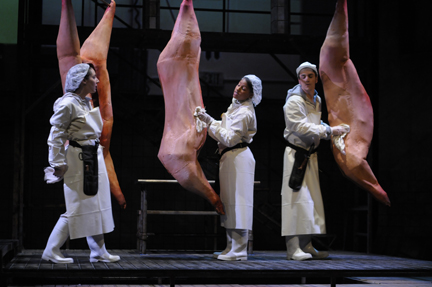
Neither here nor then …
The talented members of UC Berkeley’s Department of Theater, Dance and Performance took on Kentucky playwright Naomi Wallace’s Slaughter City for their March performance in the Zellerbach Playhouse on campus. At first reading, Wallace’s play would seem to have great appeal to young actors and audiences because it deals with issues that are both topical and controversial: race and class in the dubious industry of meat-packing, spiced up with questions of gender and sex.
Wallace’s play, however, is a shifting mélange of issues that are never quite addressed, solved, repealed or even examined with any great depth or intensity. The episodic plot pulls the audience through scenes of individual confrontations, fueled primarily by sexual desire, that often seem repetitious to no particular end.
Brandon, a young white guy who is, incorrectly, called “College Boy” by the two female workers, Maggot and Roach, hungers after Roach, an African-American packer who is some 12 years older than he and shows little interest in his unceasing come-ons. Maggot, so nicknamed by Roach because she is as whitely white as a maggot, hankers after Cod, the young scab who takes up the battle for union rights with fervor and a dollop of Marxism. Tuck, the namby-pamby African-American assistant to the manager of the slaughterhouse, reaches out to Roach only to be rebuffed.
Tension is intensified by never-ending negotiations between management and the workers over the union contract. Mr. Baquin (pronounced Bacon) is the manager of the abattoir that is the play’s setting. He is interested in the moo-d of the workers but harasses them about their cleanliness, forcing Roach to strip to her underwear and stand on a chair while Tuck cleans the back of her knees.
These scenes are strung out between the beginning and the end of the play in which we learn that Cod is really a Faustian construct, an immortal “spark” who was sold to the devil, in the form of a Sausage maker, by her pregnant mother who, trapped on the eighth floor of the burning Triangle Shirtwaist factory, cuts a deal that allows her baby to survive her fall to the street below. Since birth, Cod has traveled with the Sausage Man fomenting discontent as an infiltrator of divisiveness in the workplace. The Sausage Man in turn excites management into conflict. This plot device asks for more than a minor abandonment of logic. The mythical qualities of the characters are more credible—and less challenging—than their actions, which lack logic, even within the strange world and behaviors they inhabit.
The play’s elements are difficult to parse, and, in that way, its “magical realism”—a term frequently, and rather inaccurately, used to describe Wallace’s plays—is perhaps more realistic than most. But what was clear throughout this production, however, was that the play did not help the actors access the characters’ meaning: members of the cast seemed irresolute in their various portrayals. Only Mark Hinds (Mr. Baquin) and Daniel Petzold (Brandon) gave themselves over to their roles, carrying the necessary emotional energy that made their characters magnetic onstage and convincing.
The strongest part of the production was the stark industrial sets by Eric Sinkonnen and the video design by Kwame Braun. The long plastic strips that were the wings to offstage made an excellent surface on which to project films of a modern slaughterhouse, with corridors lined by hanging carcasses. The upper back windows of the factory also became screens on which flies buzzed and twitched as if waiting to break and enter into the slaughterhouse’s orgy of blood and death.
—Jaime Robles
Originally published in the Piedmont Post
